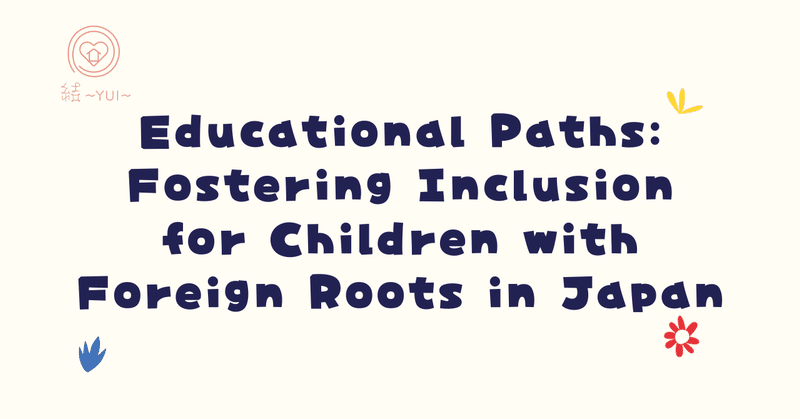
Educational Paths: Fostering Inclusion for Children with Foreign Roots in Japan
Hello, we are YUI!
We have introduced Japan's education system in our previous note.
Today, we would like to put the focus back on the children's parents. Let's talk about the educational environments parents create for children.
Introduction
The social integration of foreign residents has emerged as a significant challenge in Japanese society. Particularly, the educational environment for children with roots in foreign countries stands as a crucial element in this integration process. In recent years, the number of children with foreign roots in Japan has seen a rapid increase, growing by 1.74 times from 2008 to 2020. This surge reflects Japan's evolving demographics, with a rising population of children from diverse cultural backgrounds.
To facilitate the self-reliance and societal contributions of foreign residents, comprehensive policies and strengthened support systems are essential. This article delves into the intricacies of different visa types in Japan and their impact on the educational environments of children with foreign roots, using the case study of Higashi-Hiroshima City as an illustrative example.
Types of Japanese Visas
Japan has various types of visas, each serving a distinct purpose for foreigners coming to the country. These visas encompass a wide range, including work visas, student visas, and family residence visas, each tailored to specific needs and objectives. This table lists the categories of visas for work and long-term stay in Japan.

Parents can significantly influence the learning experiences of their children
The educational environments of children with foreign roots are influenced significantly by the type of visa their parents hold. For instance, children of parents on family residence visas may have different learning experiences compared to those with parents on work visas. In households where parents have family residence visas, there is often a strong emphasis on maintaining their native language alongside Japanese.
Furthermore, family residence visas often imply a longer stay in Japan, providing children with a stable educational environment and a sense of continuity in their schooling. These children also have greater access to local communities, allowing them to build a broader social network and gain cultural experiences.
On the other hand, children of parents with work visas may face different challenges associated with more frequent relocations and potentially less stable family environments due to work-related demands.
Communities Within and Around
Traditionally, foreign enclaves have formed informal networks, providing support and information sharing within immigrant communities. However, foreign residents are not only concentrated in such enclaves but also widely distributed in non-enclave areas, where socio-economic integration can pose challenges.
In non-enclave areas, recognizing and supporting foreign residents can be difficult, resulting in limited assistance from local authorities. The formation of ethnic networks is challenging, and reliance on support from fellow countrymen may not be feasible. Foreign residents with lower levels of social integration often require external support, making addressing this issue an urgent priority.
Case Study of Higashi-Hiroshima City
The pie chart indicates the proportions of various residence statuses in Higashi-Hiroshima.

Study Abroad (31%) and Permanent Resident (23%):
These categories likely provide a more stable environment, which is conducive to a child's continuous educational development.
Family Stay (20%) and Specially Designated Activities (9%):
Children in families under these categories may have varying degrees of access to educational support. The informal networks in Higashi-Hiroshima can provide a rich environment for daily language practice, but academic language acquisition might require additional support such as mother tongue education.
Special Permanent Resident (9%) and Other (8%):
These groups include a wide range of situations, but children here may also be at risk of educational challenges if their families are not well-integrated into local support systems.
Conclusion
The case study of Higashi-Hiroshima City emphasizes the critical importance of providing unwavering support for families and children with diverse visa statuses to facilitate their personal growth and development. Whether it's children of parents on family residence visas or those with parents on work visas, each group faces unique challenges and opportunities that shape their educational journey.
What we have to do is not only aim to aid in children's learning of the Japanese language and culture but also foster a sense of belonging and acceptance within the community.
By nurturing the minds and well-being of these young individuals, we can ensure that every child, regardless of their background, has the opportunity to flourish and thrive in a diverse and inclusive society.
良いお年をお迎えください!
If you would like to know more, please do not hesitate to contact me via comments, SNS, or email. We are here to assist and support you whenever you need, whether it's for information, guidance, or just a friendly conversation.
Translation
If you want to translation this article into your own language.
Please copy this article and use this tool.
→DeepL翻訳:高精度な翻訳ツール
References
外国にルーツのある子どもたちの成育環境と健康被害に関する地理的研究
東広島市における外国人居住分布と生活実態に関する考察
SNS
Facebook: 結YUI | Facebook
Instagram: 結〜YUI〜 (日本語教室.情報発信.居場所)(@yui_connect_) • Instagram写真と動画
Contact us
E-mail: family.shien.hu@gmali.com
この記事が気に入ったらサポートをしてみませんか?
